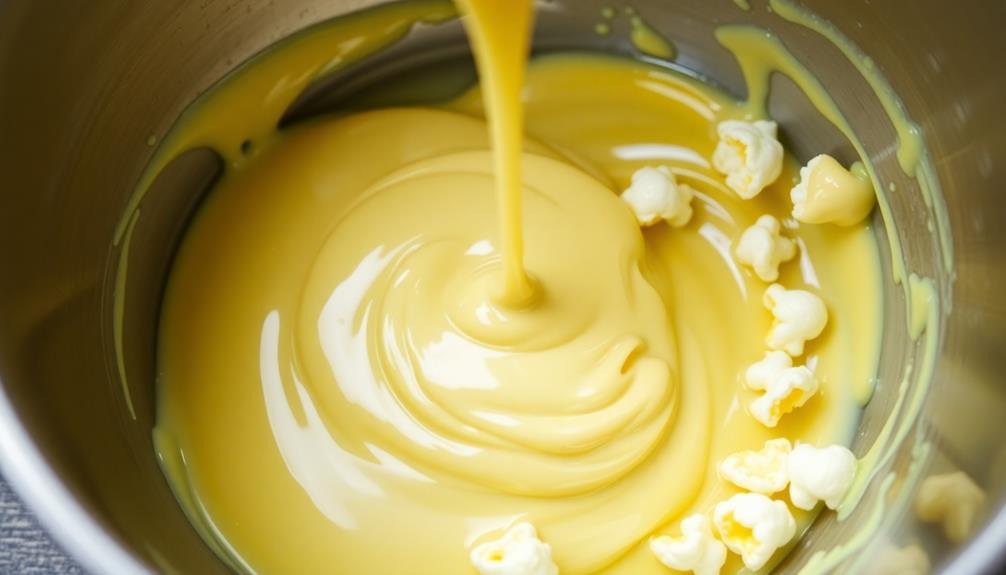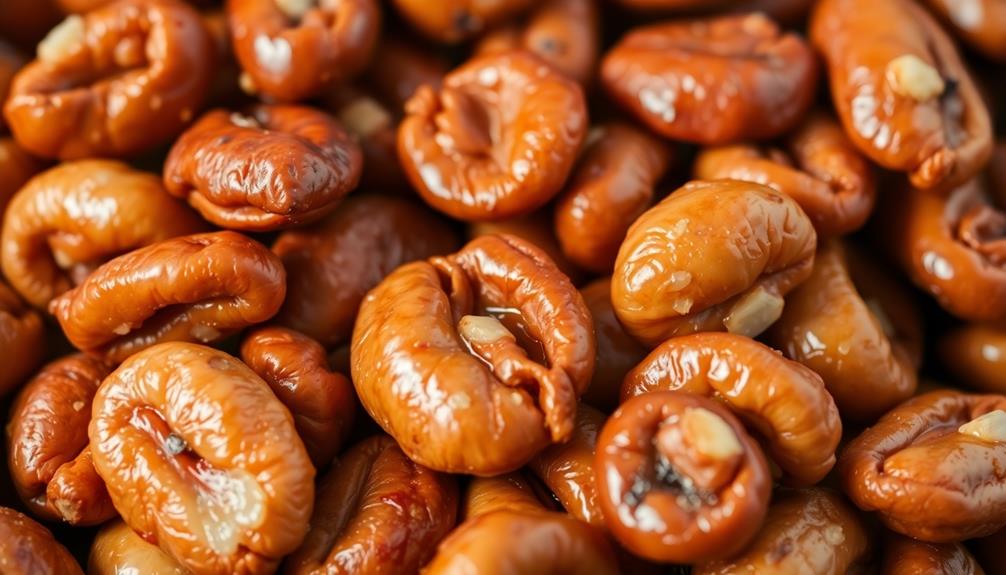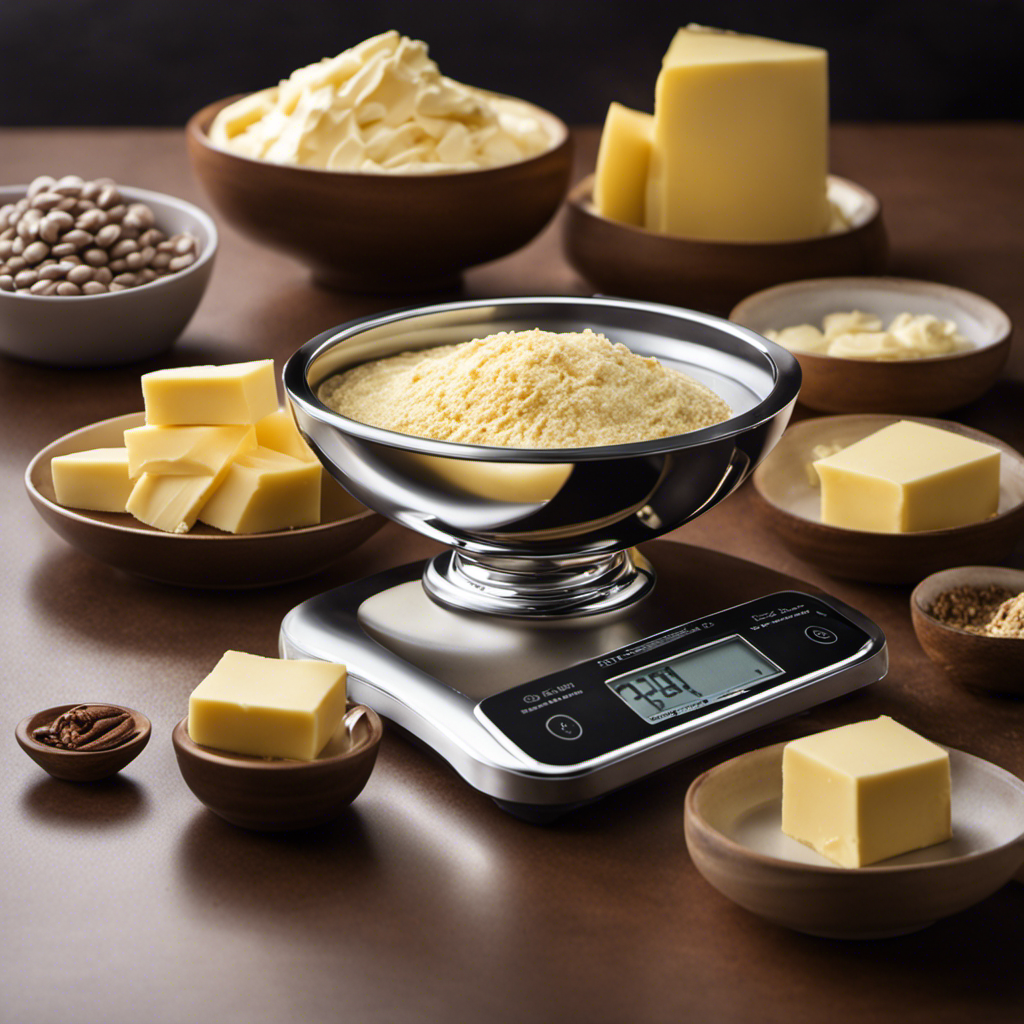You can recreate that irresistible buttery, cinema-style popcorn at home with a few simple tricks. Start with high-quality kernels, then pop them in coconut or vegetable oil. Melt unsalted butter with seasonings like garlic powder and Parmesan for a rich, flavorful coating. The key is getting that perfect balance of salty, savory, and just the right amount of butter. With a little practice, you'll be enjoying movie theater-worthy popcorn from your very own kitchen. And if you want to dive deeper into the secrets behind that iconic popcorn flavor, keep reading for more details.
Key Takeaways
- Use high-quality popcorn kernels, coconut or vegetable oil, and unsalted butter to achieve the perfect buttery, cinema-style flavor.
- Heat the oil and kernels over medium-high heat, shaking the pot gently for even popping, to create the light, fluffy texture.
- Melt the butter with salt and optional seasonings like garlic powder, onion powder, or Parmesan cheese to enhance the flavor.
- Pour the freshly popped kernels into the saucepan with the melted butter, and gently toss to ensure an even coating.
- Serve the popcorn immediately while hot for the best taste and aroma, replicating the movie theater experience at home.
History

The history of movie theater popcorn traces back to the late 19th century, when street vendors first began popping and selling this snack to moviegoers.
As the cinema industry grew, so did the popularity of popcorn. Vendors would wheel their carts up and down the aisles, the tantalizing aroma drawing in hungry patrons.
By the 1920s, movie theaters began installing popcorn machines right in the lobby, making it a staple cinema concession.
Over the decades, the recipe and preparation methods evolved. Theaters experimented with different oils, seasonings, and equipment to achieve the perfect balance of fluffy, buttery goodness.
The introduction of pre-packaged, microwave-ready popcorn in the 1980s made the snack even more accessible.
Today, the classic movie theater popcorn flavor remains a nostalgic favorite, reminding us of the magic and excitement of going to the movies. Its history is woven into the fabric of the cinema experience.
Recipe

Capturing the perfect movie theater popcorn experience at home requires attention to detail and the right techniques. Popcorn is more than just a snack – it's an integral part of the cinematic experience, with its enticing aroma and satisfying crunch. Replicating this classic concession stand flavor requires a specific approach to ensure the popcorn is light, fluffy, and evenly coated in a rich, buttery flavor.
Just like the refreshing experiences found at DFW Water Parks, creating a delightful atmosphere is key to enjoying your popcorn.
The key to achieving movie theater-quality popcorn lies in the method of preparation. By understanding the science behind popping corn and the importance of using the right ingredients, home cooks can craft a treat that rivals the offerings of their local multiplex.
Ingredients:
- 1/2 cup high-quality popcorn kernels
- 3 tablespoons coconut oil or vegetable oil
- 2 tablespoons unsalted butter
- 1/2 teaspoon salt
Instructions:
In a large, heavy-bottomed pot or Dutch oven, heat the oil over medium-high heat. Add the popcorn kernels, ensuring they're in a single layer. Cover the pot with a lid and wait for the popping to begin.
Once the popping slows to 2-3 seconds between pops, remove the pot from the heat and transfer the popcorn to a large bowl. Melt the butter and drizzle it over the hot popcorn, tossing to coat evenly. Sprinkle the salt over the popcorn and toss once more to distribute it.
For optimal results, be sure to use fresh, high-quality popcorn kernels and avoid overcrowding the pot during the popping process. The combination of the right oil, proper heating technique, and timely butter and salt application is the secret to achieving that irresistible movie theater flavor.
Cooking Steps

First, you'll want to purchase some quality popcorn kernels.
Next, heat the kernels in oil until they pop into fluffy, golden perfection.
Finally, drizzle the popped popcorn with a delicious, melted flavored butter for that classic movie theater taste.
Serve it up hot and enjoy every buttery, salty bite!
Step 1. Purchase Popcorn Kernels

Gather up some high-quality popcorn kernels to get started. Look for kernels labeled "popping corn" or "old-fashioned movie theater popcorn." These are typically larger and will give you that classic fluffy texture.
Avoid the small, pre-popped varieties – they just won't deliver the same cinema-worthy experience. Once you've got your kernels, check the expiration date and make sure they're fresh. Stale popcorn can taste bitter and tough.
When you're ready to pop, measure out about 1/2 cup of kernels per batch. This will ensure your popcorn has plenty of room to expand without overcrowding the pot.
With the right kernels in hand, you're one step closer to enjoying movie theater-worthy popcorn in the comfort of your own home. Just wait until you catch that irresistible buttery aroma wafting through your kitchen – it'll have you feeling like you're back at the movies in no time.
Step 2. Heat Popcorn Kernels in Oil

Once you have the popcorn kernels ready, it's time to start heating them in oil. You'll want to choose a heavy-bottomed pot or Dutch oven for this step – the sturdy construction will help the kernels cook evenly.
Pour in enough oil to cover the bottom of the pot, about 2-3 tablespoons. Bring the oil to a medium-high heat, allowing it to get nice and hot.
Next, add the popcorn kernels in a single layer. They should sizzle gently when they hit the oil. Put a lid on the pot, but leave it slightly ajar to let the steam escape.
As the kernels heat up, you'll start to hear them popping – this is the magic happening! Gently shake the pot back and forth to ensure even cooking.
Once the popping slows to 2-3 seconds between pops, remove the pot from the heat. Keep the lid on for a minute to allow any remaining kernels to finish popping.
Then, transfer the fluffy, golden popcorn to a serving bowl. Time to add your favorite toppings and enjoy the perfect movie theater experience right at home!
Step 3. Add Flavored Butter

With the popcorn kernels popped to perfection, it's time to add the finishing touch – a delectable, flavored butter.
In a small saucepan, melt a few tablespoons of unsalted butter over medium heat. Once the butter is fully melted, stir in a pinch of salt, a dash of garlic powder, and a sprinkle of onion powder.
For an extra flavor boost, you can also add a teaspoon of Parmesan cheese or a splash of Worcestershire sauce.
Whisk the ingredients together until they're well combined, creating a rich, aromatic butter.
Carefully pour the flavored butter over your freshly popped popcorn, using a spoon to drizzle it evenly.
Gently toss the popcorn to ensure every kernel is coated in the buttery goodness.
The combination of the salty, savory, and slightly tangy flavors will transport you right back to that classic movie theater experience.
Enjoy your perfectly seasoned, movie-worthy popcorn!
Step 4. Add Cooked Popcorn to Melted Butter

After perfecting the popcorn, carefully pour the freshly popped kernels into the saucepan with the melted flavored butter. The warmth of the popcorn will help the butter melt and blend seamlessly.
Gently stir the mixture, ensuring every kernel is evenly coated. You'll notice the rich, buttery aroma filling the air, making your mouth water in anticipation. As you continue stirring, the butter will create a glossy sheen, adhering to each piece of fluffy popcorn.
Interestingly, enjoying your popcorn with a cup of coffee can also enhance the experience, as coffee may improve cognitive function and mood enhancement, making your movie night even more enjoyable coffee's health benefits.
Take a moment to admire the beautiful, golden hue – it's just like the popcorn you'd get at the cinema. Now, use a spoon to scoop up a generous portion, allowing any excess butter to drip back into the pan.
Bring the popcorn to your lips and take a bite. The perfect balance of salt and butter hits your taste buds, transporting you to the magic of the movie theater experience.
Step 5. Serve Immediately and Enjoy

Serve the popcorn immediately, while it's still piping hot and the butter is perfectly melted. The aroma will fill the room, making your mouth water in anticipation.
Grab a big bowl and pour the freshly popped kernels into it, making sure to scrape out every last bit from the pot. Drizzle the warm, golden butter over the top, letting it soak into every nook and cranny. Give the popcorn a gentle toss to coat it evenly.
Now, settle in and enjoy this movie theater-worthy treat. Grab a handful and savor the buttery, salty goodness. The light, fluffy texture and bursts of flavor will transport you right to the concession stand.
As you pop each kernel in your mouth, the satisfying crunch will have you reaching for more. This popcorn is the perfect companion to your favorite film, whether you're cuddled up on the couch or sitting in a plush theater seat.
Indulge in this homemade delight and experience the magic of the movies in your own home.
Final Thoughts

Achieving the perfect movie theater popcorn is a worthwhile endeavor. While the process may take some trial and error, the rewarding outcome is well worth the effort.
Imagine the satisfying crunch as you sink your teeth into a fluffy, golden kernel, savoring the buttery richness that melts on your tongue. The aroma alone is enough to transport you back to the excitement of movie night. You might even consider enhancing your popcorn experience by incorporating essential oils for a unique twist; for instance, a hint of essential oils for respiratory health can elevate your movie night atmosphere.
Don't be discouraged if your first few batches don't quite measure up. Mastering the art of popcorn-making takes practice, but with the right techniques and a little patience, you'll be enjoying cinema-quality popcorn in the comfort of your own home.
Experiment with different oils, seasonings, and popping methods until you find the perfect combination that suits your taste buds. The joy of perfecting this classic snack is half the fun.
Frequently Asked Questions
Is Movie Theater Popcorn Unhealthy?
Yes, movie theater popcorn is generally considered unhealthy due to the high amounts of saturated fat, sodium, and calories from the butter and oil used in its preparation. It's best enjoyed in moderation as an occasional treat.
Can I Use Microwave Popcorn Instead?
You can use microwave popcorn, but it won't have the same cinema-style flavor as movie theater popcorn. Microwave popcorn is typically less buttery and has a different texture than the popcorn you'd get at the theater.
How Long Does Homemade Popcorn Last?
Homemade popcorn doesn't last as long as you'd like. It's best enjoyed within a day or two of popping. The kernels can lose their crispness and flavor over time. So, make just what you need and savor it fresh.
Can I Make Popcorn Without a Popcorn Machine?
Absolutely! You can make delicious popcorn without a popcorn machine. All you need is a pot with a tight-fitting lid, some oil, and your favorite kernels. Just pop them on the stovetop, and you'll have fresh, homemade popcorn in no time.
Is There a Way to Make Popcorn Less Greasy?
Yes, you can make less greasy popcorn at home. Use an air popper or stovetop method with minimal oil. Opt for healthier oils like olive or coconut oil. Avoid over-buttering and experiment with seasonings to add flavor without excess grease.










